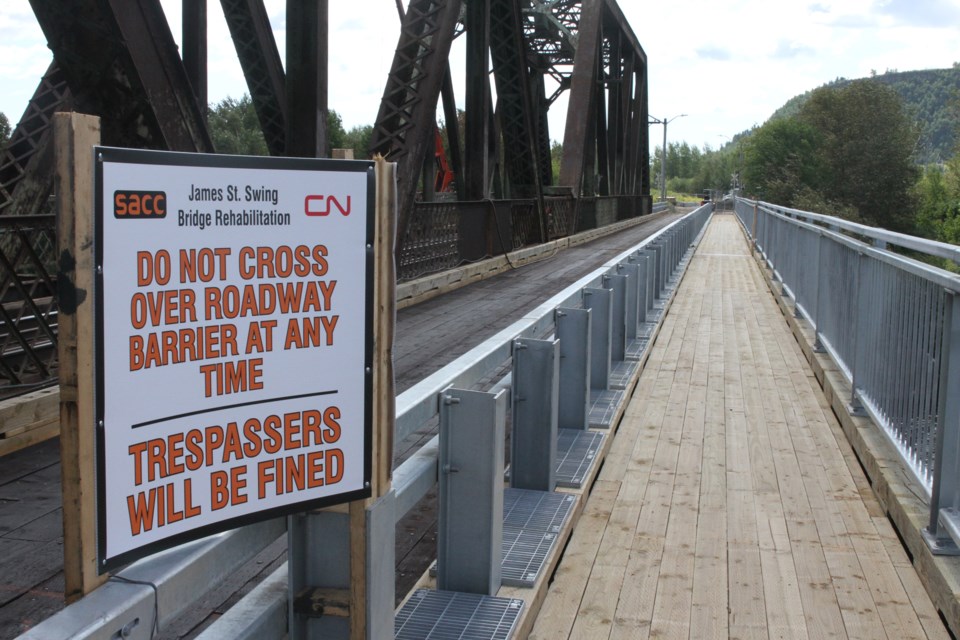A spokesperson with CN Rail has confirmed that construction on the James Street Swing Bridge is expected to be completed by the end of 2019.
The railway company informed Dougall Media on Aug. 31 that construction on the southbound lane, which would allow vehicle access into Fort William First Nation, is complete.
The southbound pedestrian lane is also complete, and has been open to pedestrians for a number of months.
CN Rail said construction on both vehicular and pedestrian lanes for northbound traffic is now underway, and is expected to be completed before the end of the calendar year. The spokesperson said it will look similar to the completed southbound lanes.
Sacchetti Construction was contracted to repair the bridge.
The CN-owned century-old bridge, connecting Thunder Bay to Fort William First Nation across the Kaministiquia River, has been closed to vehicular traffic since a fire broke out on the northern approach spans on the evening of Oct. 29, 2013.
After a long legal battle between CN Rail and the City of Thunder Bay, the Supreme Court of Canada dismissed an appeal by CN in March of 2019, ordering CN to reopen the span to vehicular traffic.
In March, Fort William First Nation chief Peter Collins said preliminary discussions with CN indicated the railway could have the bridge reopened by Aug. 31.
Legal avenues pursued by the city in regards to the Swing Bridge case have cost more than $1 million, which Dougall Media learned last year through a Freedom of Information request.
In 2018, CN claimed the repairs would cost between $4 million and $6 million.
James Street Swing Bridge timeline
- Oct. 29, 2013: Fire breaks out on the bridge, closing both the road and rail portions of the structure.
- Nov. 1, 2013: Rail traffic resumes crossing the bridge.
- Feb. 9, 2015: Thunder Bay city council rejects CN's "final offer" to reopen bridge without going to court.
- Feb. 20, 2015: CN files case before Ontario Superior Court of Justice, requesting judge to determine its obligations under 1906 agreement.
- Feb. 24, 2015: City announces it has filed its own Superior Court suit, arguing CN should be bound by the 1906 agreement to maintain the bridge.
- Jan. 20, 2016: Superior Court Justice John Fregeau rules city's application to proceed with CN's case to be stayed.
- April 2016: Office of the Fire Marshal completes investigation into fire, classifying cause as undetermined.
- July 7, 2016: City-contracted engineers granted access to inspect the bridge.
- March 1-3, 2017: Case is heard in a Thunder Bay courtroom by Superior Court Justice Patrick Smith.
- June 9, 2017: Ontario Superior Court Justice Patrick Smith dismisses the city's case, ruling CN does not have to reopen the bridge.
- July 10, 2017: City files notice of appeal before the Ontario Court of Appeal
- Jan. 25, 2018: The Ontario Court of Appeal hears the case.
- June 11, 2018: The Ontario Court of Appeal accepts the city's appeal, finding CN breached 1906 agreement and orders railway to reopen the bridge.
- July 18, 2018: Thunder Bay mayor Keith Hobbs says the city has been informed by CN that it intends to appeal the June 2018 ruling.
- Nov. 16, 2018: Ontario Court of Appeal refuses CN's request for a two-month stay in the order requiring the railway to reopen the bridge to vehicular traffic.
- March 28, 2019: Supreme Court of Canada dismisses CN's leave to appeal application, with costs.
This story originally appeared on TBNewsWatch.com.




